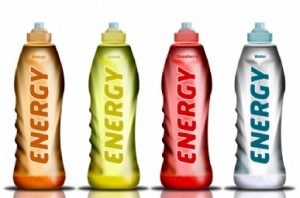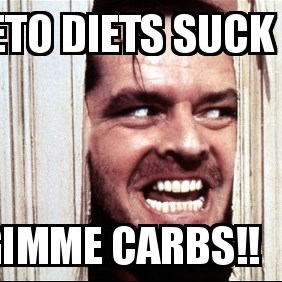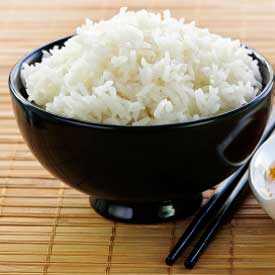by Kedric Kwan CISSN. The world of carbohydrates can be one plague with controversy. It seems like people tend to polarize the intake of carbohydrates from either completely low to no carbohydrate or having a high carb diet all day, every day. It’s either cotton candy or some gross sugar-free substitute. And somewhere in that morass of social media confusion, lies the truth.
When the role of carbohydrate is concerned, it is mainly involved in keeping muscle glycogen and blood glucose elevated to facilitate exercise performance.
Classic studies have shown the role skeletal muscle glycogen content plays in sustaining exercise or sporting performance. My favourite one in particular is this study done in soccer players. The finding of the summary is in the table below:
| High Glycogen | Low Glycogen | |
| Muscle glycogen at start of game: | 100% | 50%
|
| Muscle glycogen at half time: | 40% | 7% |
| Muscle glycogen at full time: | 10% | 0% |
| Distance covered first half | 6,100m | 5,600m |
| Distance covered second half | 5,9000m | 4,1000m |
| Total distance covered | 12,000m | 9,7000m |
| Percentage walking | 27% | 50% |
| Percentage sprinting | 24% | 15% |
This study basically showed that the football players with higher glycogen covered a staggering 1,300m more and sprinted more and walked less compared to the ones who had low muscle glycogen (Saltin 1973).
You should be convinced now that carbohydrates do play a huge role in both exercise and sporting performance. However, just because something is good doesn’t mean that constantly consuming a ton if it will bring additional benefits.
In the endurance world, performance is definitely affected by carbohydrates and recent studies have indeed demonstrated that (Leckey et al., 2015, Torrens et al., 2016). However, in 8 longitudinal studies evaluating the relationship between a high carbohydrate diet (HCHO) and moderate carbohydrate diet (MCHO), 5 studies showed no difference in performance improvement of HCHO compared to MCHO when it came to the actual performance test (Burke et al., 2004).
This leaves us with the question, is constantly having high carbohydrate availability the best way to maximize endurance performance? Or could strategically periodizing phases of training with low carbohydrate availability enhance performance to a greater extent?
Mitochondrial physiology
In order to fully understand the content of this article we need to understand a little physiology of endurance performance. Besides the role the heart plays, the two ways someone can increase their endurance performance is by increasing the number of mitochondria also known as mitochondria volume density or by improving mitochondrial function. This article will focus mainly on the increasing of mitochondrial volume density also known as mitochondrial biogenesis, instead of its function.
Mitochondria is the site where energy in the form of ATP is produced so the more mitochondria we have, the more ATP we can produce which theoretically leads to an improvement of performance. Since the improvement of performance could be thought of the accumulated response from an acute exercise bout, constant training would result in an improvement of endurance performance through increased mitochondrial volume.
Something that governs the increase of mitochondria is the transcription factor called Peroxisome proliferator-activated receptor gamma coactivator 1-alpha (PGC-1α). This has been labelled as the “master regulator” of mitochondrial biogenesis and training in a state of reduced carbohydrate availability seems to augment this by upregulation upstream regulators and protein kinases that are involved in the signalling pathway for mitochondrial biogenesis.
One of the major protein kinases that up regulates PGC-1α is the protein kinase called AMP- activated protein kinase (AMPK). This protein responses mainly to energy availability and the ratio of AMP to ATP, a higher level of AMP concentration simply signals that energy availability is low and AMPK will be upregulated (Alexander and Walker, 2011). Another protein kinases is the p38 mitogen-activated protein kinase (p38 MAPK) which is a protein that is sensitive to stress that takes place during exercise mainly in the form of cellular perturbation and oxidative stress. This two proteins act downstream on PGC-1α, increasing it’s activity hence up regulating mitochondrial biogenesis.
Besides PGC-1α, another protein called p53 has also been implicated in the role of mitochondrial biogenesis. Similar to how PGC-1α is upregulated by AMPK and p38 MAPK, p53 is also one of the downstream targets of those proteins.
Training with low carbohydrate availability – the evidence.
One of the most common ways to reduce carbohydrate availability is to train twice a day without ingesting any form of carbohydrate after the first exercise bout. What happens when exercise is commenced with low carbohydrate availability is that the cellular perturbation is increased and energy availability would be greatly reduced hence AMPK and p38 MAPK activity would increase and act on it’s downstream targets. This was first seen in a study done by Hansen and workers (2005) in which they recruited a group of seven untrained males and have them perform single leg knee extensions at 75% maximal power out (Pmax). One leg trained twice a day, every other day (LOW) while the other once a day, every day (HIGH). This training  protocol lasted 10 weeks. Only water was ingested while training the LOW leg to ensure that the second bout of training was commenced with lower glycogen stores while the HIGH leg that was trained once every other day trained with regular glycogen levels. After 10 weeks the LOW leg showed higher a increase of Citrate Synthase (CS) which is a marker of increased mitochondrial volume and HAD which shows greater oxidative capacity, compared to the HIGH. The LOW leg also performed better in a time to exhaustion test (TTE) compared to the HIGH.
protocol lasted 10 weeks. Only water was ingested while training the LOW leg to ensure that the second bout of training was commenced with lower glycogen stores while the HIGH leg that was trained once every other day trained with regular glycogen levels. After 10 weeks the LOW leg showed higher a increase of Citrate Synthase (CS) which is a marker of increased mitochondrial volume and HAD which shows greater oxidative capacity, compared to the HIGH. The LOW leg also performed better in a time to exhaustion test (TTE) compared to the HIGH.
This study was definitely a huge pain to go through and in most countries, it wouldn’t even get approved by ethics. Hence ecological validity isn’t particularly high but this was simply a “proof of principle” study that eventual lead to more studies being done. Another thing to take note of is that this study was done with untrained population and the effects on trained population might be different
To create a study that had greater real world application, a similarly study was done using a cycling model on 12 endurance trained cyclist or triathletes. Using a similar design in a cycling model, one group trained twice a day with both steady state (SS) and high intensity interval training (HIIT) done on the same day (LOW) every other day while the other group once a day, every day (HIGH) alternating between SS and HIIT for 3 weeks. Participants cycled for an initial 100 minute of SS cycling followed by 8 x 5 minutes of HIIT at 75-80% Pmax (Yeo et al., 2008).
The LOW group was given only water while the high group had no nutritional restriction. In the first two weeks, the LOW group had reduced power output compared to the HIGH but that stabilized in the third week. After 3 weeks, biopsies showed a higher increase in CS and β-HAD in the LOW in agreement to the results reported by Hansen et al. The LOW group also had  higher lipid oxidation compared to the HIGH. A 60 minute time trial was also performed to measure performance improvement but there was no difference between groups. Unlike the study done by Hansen et al which showed an improvement in both mitochondrial adaptation and performance (TTE) Yeo et al couldn’t display an additional performance benefit despite enhance mitochondrial adaptation in the LOW group.
higher lipid oxidation compared to the HIGH. A 60 minute time trial was also performed to measure performance improvement but there was no difference between groups. Unlike the study done by Hansen et al which showed an improvement in both mitochondrial adaptation and performance (TTE) Yeo et al couldn’t display an additional performance benefit despite enhance mitochondrial adaptation in the LOW group.
Hulston and colleagues (2010) performed what was almost a replication of the study conducted by Yeo et al with small changes in different training parameters and what they showed was consistent with the previous findings, as markers of mitochondrial adaptation (CS and β-HAD) and lipid oxidation increased while a drop in power output was seen in the low group and both groups showed similar improvement in a time trial test.
Despite the lack of performance improvement, most acute studies done would be in agreement with the chronic studies showing additional improvement in markers of mitochondrial adaptation (some acute studies did not show improvements but will be touched on below). Using a cycling model, Psilander and colleagues (2013) recruited 10 subjects to investigate the acute response to training with reduced glycogen availability on highly trained athletes. They performed exercise either in a high glycogen session or low glycogen session with at least a week in between sessions. On the first day, a protocol to deplete glycogen was done for both high and low sessions. The high session then consumed two high carbohydrates meal and returned for the exercise test 14 hours later, whereas the low session was commenced 14 hours later after consuming two low carbohydrate meal. The exercise test consist of 6 intervals of 10 minutes with 4 minutes of active rest in between intervals. The first interval started at 72.5% Vo2 max and subsequent intervals were reduced by 2.5% making the last interval 60% of Vo2 max. A muscle biopsy obtained 3 hours post test showed a greater increase in PGC-1α expression with also an increase of the mitochondrial enzyme pyruvate dehydrogenase lipoamine kinase isoenzyme 4 (PDK-4).
In a different study, increases of PDK- 4 and Carnitine palmitoyltransferase I (CPT-1), another mitochondrial enzyme was higher in the group that performed exercise in a lower glycogen state (Bartlett et al., 2013). 8 participants performed a glycogen depletion protocol in the evening lasting 68 minutes. Participants returned the next morning to perform High Intensity Training (HIT) running for 6 x 3 minutes at 90% Vo2 max. Participants exercised either in a high (HIGH) carbohydrate state or low (LOW) carbohydrate state. In the HIGH state, participants were fed carbohydrate before, during and after HIT while in the LOW state, no carbohydrate was fed before, during and after HIT. Participants switched groups (HIGH to LOW or LOW to HIGH) and repeated the protocol with a minimum of 7 days rest between protocols. Phosphorylation of p53 was also higher in LOW compared to HIGH but the increase of PGC-1α was similar between both groups.
So far every exercise protocol here has been done using an endurance exercise model, for all the meat heads out there, don’t lose hope as there is one study that used resistance training to investigate similar hypothesis.
Low carbohydrate availability and resistance exercise.
In this study, Camera and workers (2015) recruited participants to perform resistance exercise to investigate the acute response on mitochondrial adaptation. A group of 8 healthy fit males were recruited and they performed a glycogen depletion protocol on one leg. Participants then consumed a low carbohydrate dinner and returned the next morning to perform resistance exercise after an overnight fast to ensure one leg would perform the exercise in a low glycogen state. Participants then performed 8x 5 minutes at 80% of their 1RM with 3 minutes rest in
between legs. The leg that performed resistance exercise in a low glycogen state had greater phosphorylation of p53 compared to the normal leg and PGC-1α also had a higher increase in the low glycogen leg.
As far as the acute and chronic changes in mitochondrial adaptation is concerned, it’s safe to say that training in a low glycogen/carbohydrate state definitely enhances this response. When it comes to performance, it’s not so clear cut.
Two other studies showed increases in both mitochondrial adaptations but when it came to the actual performance test, improvements were similar across both groups with no additional performance outcome (Morton et al., 2009, Van Proeyen et al., 2011).
Low carbohydrate availability and greater performance improvement.
However there are two studies that have been published recently that shows an improvement in performance. The first was done by Cochran and workers (2015) which showed that high intensity interval training (HIIT) performed twice a day with the second bout in a glycogen reduced state showed an improvement in a 250kj time trial compared the control group. This training protocol lasted 2 weeks. Another study was published early this year that showed that by simply altering the timing of intake of carbohydrate resulted in both a reduction in body fat and improved performance in a stimulated triathlon test (Marquetz et al., 2016).
In brief, both groups performed two bouts of exercise. The first bout of exercise took place in the evening and consisted of 8 x 5 minutes of maximum aerobic power followed by 60 minutes of cycling at 65% maximum aerobic power. The sleep low group restricted carbohydrate from their meals after the first bout of exercise up till the second bout of exercise whereas the  control group maintained carbohydrate availability with throughout the recovery period up till the second exercise bout and a carbohydrate drink was consumed during the second bout of exercise. After the second bout of exercise, the sleep low group then consumed large amount of carbohydrates to match the amount consumed by the control group. Both groups were given a protein drink before bed and total energy intake was matched between groups.
control group maintained carbohydrate availability with throughout the recovery period up till the second exercise bout and a carbohydrate drink was consumed during the second bout of exercise. After the second bout of exercise, the sleep low group then consumed large amount of carbohydrates to match the amount consumed by the control group. Both groups were given a protein drink before bed and total energy intake was matched between groups.
Improvements in triathlon simulated trial, decreased in heart rate and rate of perceived exertion took place only in the sleep low group whereas the control group showed no noticeable difference. This study is significant because it’s the first and only study that showed an improvement in performance in a group of highly trained athletes whereas the previous studies (Hansen et al and Cochran et al) was done in untrained individuals.
This is almost all the evidence there is on training with low carbohydrate availability and I hope that it has given some insight on the mechanism on how it works.
I’ve purposefully left out some evidence from the literature because I plan to include that in the next part where we will touch on the implementation of low carbohydrate availability training and how to optimise it to get a performance outcome. Part 2 coming soon!
References
Alexander, A. and Walker, C. (2011). The role of LKB1 and AMPK in cellular responses to stress and damage. FEBS Letters, 585(7), pp.952-957.
Bartlett, J., Louhelainen, J., Iqbal, Z., Cochran, A., Gibala, M., Gregson, W., Close, G., Drust, B. and Morton, J. (2013). Reduced carbohydrate availability enhances exercise-induced p53 signaling in human skeletal muscle: implications for mitochondrial biogenesis. AJP: Regulatory, Integrative and Comparative Physiology, 304(6), pp.R450-R458.
Burke, L., Kiens, B. and Ivy, J. (2004). Carbohydrates and fat for training and recovery. Journal of Sports Sciences, 22(1), pp.15-30.
Camera, D., Hawley, J. and Coffey, V. (2015). Resistance exercise with low glycogen increases p53 phosphorylation and PGC-1α mRNA in skeletal muscle. European Journal of Applied Physiology, 115(6), pp.1185-1194.
Cochran, A., Myslik, F., MacInnis, M., Percival, M., Bishop, D., Tarnopolsky, M. and Gibala, M. (2015). Manipulating Carbohydrate Availability Between Twice-Daily Sessions of High-Intensity Interval Training Over 2 Weeks Improves Time-Trial Performance. IJSNEM, 25(5), pp.463-470.
Hansen, A., Fischer, C., Plomgaard, P., Andersen, J., Saltin, B. and Pedersen, B. (2005). Skeletal muscle adaptation: training twice every second day versus training once daily. Scand J Med Sci Sports, 15(1), pp.65-66.
Hulston, C., Venables, M., Mann, C., Martin, C., Philip, A., Baar, K. and Jeukendrup, A. (2010). Training with Low Muscle Glycogen Enhances Fat Metabolism in Well-Trained Cyclists. Medicine & Science in Sports & Exercise, 42(11), pp.2046-2055.
Leckey, J., Burke, L., Morton, J. and Hawley, J. (2015). Altering fatty acid availability does not impair prolonged, continuous running to fatigue: evidence for carbohydrate dependence. Journal of Applied Physiology, 120(2), pp.107-113.
Marquet, L., Brisswalter, J., Louis, J., Tiollier, E., Burke, L., Hawley, J. and Hausswirth, C. (2016). Enhanced Endurance Performance by Periodization of CHO Intake. Medicine & Science in Sports & Exercise, p.1.
Morton, J., Croft, L., Bartlett, J., MacLaren, D., Reilly, T., Evans, L., McArdle, A. and Drust, B. (2009). Reduced carbohydrate availability does not modulate training-induced heat shock protein adaptations but does upregulate oxidative enzyme activity in human skeletal muscle. Journal of Applied Physiology, 106(5), pp.1513-1521
Psilander, N., Frank, P., Flockhart, M. and Sahlin, K. (2012). Exercise with low glycogen increases PGC-1α gene expression in human skeletal muscle. European Journal of Applied Physiology, 113(4), pp.951-963.
Saltin, B. (1973). Metabolic fundamentals in exercise. Medicine & Science in Sports & Exercise, 5(3), pp.137-146.
Torrens, S., Areta, J., Parr, E. and Hawley, J. (2016). Carbohydrate dependence during prolonged simulated cycling time trials. European Journal of Applied Physiology.
Van Proeyen, K., Szlufcik, K., Nielens, H., Ramaekers, M. and Hespel, P. (2010). Beneficial metabolic adaptations due to endurance exercise training in the fasted state. Journal of Applied Physiology, 110(1), pp.236-245.
Yeo, W., Paton, C., Garnham, A., Burke, L., Carey, A. and Hawley, J. (2008). Skeletal muscle adaptation and performance responses to once a day versus twice every second day endurance training regimens. Journal of Applied Physiology, 105(5), pp.1462-1470.
About the Author: Kedric Kwan CISSN
Kedric is a performance nutritionist (CISNN) certified through the International society of sports nutri tion (ISSN) and is currently pursuing his MSc. His researc
tion (ISSN) and is currently pursuing his MSc. His researc
h is currently focusing on
carbohydrate and it’s effect on sports performance with a particular interest in the molecular signalling pathways. He has worked with professional football players, powerlifters and endurance athletes but his current clientele consist of strength/power athletes and the general weekend warrior. His aim is to able to translate the ABC soup of complex science into something palatable for the general population. He is also a competitive powerlifter and when he is not spending time nerding over science or lifting heavy weights, he enjoys indulging in ice cream and reading about superheroes. If you enjoy any of the aforementioned things, feel free to drop him a holla!





